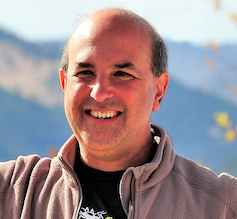Three weeks ago now (swish, there goes the time) I was at the CCLI conference sponsored by NSF for projects that have received funding from their division of undergraduate education. We were there showing results from our EvoBeaker studies and our plans under our current Phase II EvoBeaker project. Our poster was of course showing some pretty cool results and labs (I say so myself) and there was a ton of other really interesting work being presented as well. Here’s my round-up, a somewhat random collection of some posters where I had a good talk with the authors.
I naturally gravitated towards some of the technology-based projects, or projects around assessment, since that’s our focus at SimBiotic, but a couple of fun wet lab projects grabbed my attention too. Larry Blumer at Morehouse College is developing a whole curriculum using bean beetles, where you can apparently do all kinds of experiments in ecology and evolution. I like beans, and beetles, and the pictures of beetles astride their beans sure look cute. Carolyn Thomas at Ferrum College and a bunch of her colleagues have put together a consortium of a number of small teaching colleges in the Appalachians into a watershed collaboration called CAWS. Students in ecology-related classes in each of those schools gather data on some aspect of a watershed near their school, and then all the data from all the classes are put onto a central server from which all participants can access it. So students at each school get a wide range of data, beyond that which they can collect themselves. Together with a bunch of teaching materials they’ve developed for the project, it sounds like a fun and powerful way to learn how to do science.
One of my objectives for the meeting was to look for resources for assessing student learning. In addition to a session on assessment (see my last post), Michael Klymkowsky from University of Colorado, Boulder was presenting results from the biological concept inventory he is developing using both low tech (student interviews) and some higher tech analysis software run on student essays. A really nice approach. One thing we’re trying now from his methods is to have students explain some biological topic to a non-expert interviewer. I’m hopeful that putting the student in the place of authority will pull out some hidden misconceptions. Another interesting assessment I saw was done by Denise Woodward from Penn State University on how well some web-based animations she helped write worked for teaching biology. Her group compared students who sat through a traditional lecture to those that used an animation. The learning gains were the same, suggesting that just making an animation of a complex process is not enough to increase student learning. Kathleen Dixon from the University of Arizona was looking for student misconceptions in quantitative concepts in cell biology, starting with diffusion and osmosis among other things. She was finding some of the same problems in her students that we found in our study which led to our OsmoBeaker labs.
There were a bunch of other great posters, it’s really a nice NSF program as far as producing innovative teaching ideas, but one last poster by Heidi Elmendorf from Georgetown was a more retro idea – having students learn by teaching. She was offering students the opportunity to develop a set of biology teaching materials and then use them in a class in the DC school system as a senior capstone project. Her assessment was all qualitative, but it sounded like a wonderful program all around. She had quotes from senior biology students saying that the first time they really understood some fundamental concept (I think mitosis and meiosis were in some quotes, things like that) was when they had to teach it. Some even found developing educational labs was a better way of understanding how to do research than their experiences working in a research lab.
– Eli Meir, SimBio founder and author



